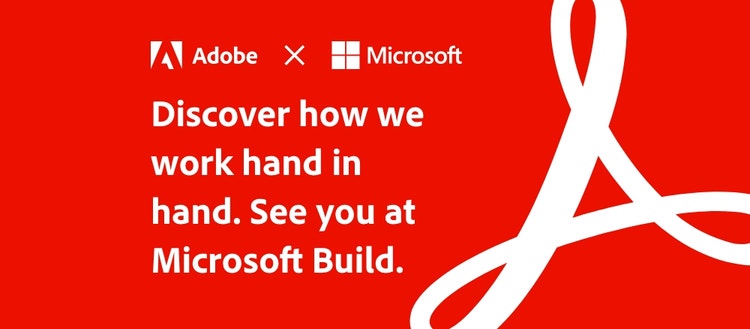Discover Adobe Document Cloud at Microsoft Build 2023

At Microsoft Build, Adobe announced Microsoft Power Automate embed for Adobe Acrobat Sign. Organizations can now access over 700+ Power Automate premium connectors and pre-created flow templates directly from Acrobat Sign to easily automate signing workflows at no additional cost to enterprise licensees. Learn more here.
Tune into our Microsoft Build panel session and visit our digital showcase. Digital registration is free.
Documents are the lifeblood of businesses. Whether it’s agreements, reports, enrollment forms, presentations or marketing collateral, most business documents today are in PDF or Microsoft file formats. With PDFs continuing to be a key document and data format enabling organizations to communicate and collaborate on the high value business information, improving document experiences is essential to maximize business efficiency.
Software development plays a key role in building new and better document experiences for customers and employees alike. Adobe offers APIs for Acrobat and Acrobat Sign, giving businesses the flexibility to revamp document experiences to fit their unique needs and existing infrastructure.
Adobe Document Cloud is committed to enabling organizations to unlock more efficient and secure ways to work and will again be a premier sponsor at the Microsoft Build developer conference.
Here’s a sneak peek to some of the topics we’ll cover:
Optimize document processes with automation
For organizations looking to remove manual work from repetitive, multi-step document workflows, Adobe provides a comprehensive portfolio of document actions that can be automated: generate documents based on data, convert PDF files, secure PDFs with passwords and permissions, extract content, get documents electronically signed or sealed, and more.
Low-code platform Microsoft Power Automate creates an environment where any supported service — Microsoft applications or beyond — can be inter-connected.
Leveraging Microsoft Power Automate, together with Adobe Acrobat Services and Acrobat Sign, businesses can build custom document workflows without the resource and time constraints of traditional software development. Top use cases include agreements and contracts, customer and employee onboarding, financial reporting and invoices, as well as data analysis and retrieval.
One example is Adobe’s own legal team that was looking to accelerate deal velocity as well as reduce errors and costs. Adobe’s legal team built a custom contracting engine on the Microsoft Power Automate platform using Acrobat Services and Acrobat Sign across agreement generation, approval, execution, storage, and discovery. With this new agreement experience, Adobe anticipates 75 percent of sales contracts to be handled through fully self-service workflows and 273 percent faster average time to execute each contract.
To improve access and speed around court documents, the City of Seattle built a digital courtroom workflow using Acrobat Sign and Microsoft Power Automate and Microsoft SharePoint. The workflow allows prosecutors to fill out forms after custody hearings and submit them for e-signature from defense attorneys and judges. Once signed, the document would automatically be emailed to all signers and an administrator who would archive the completed document. The digital workflow allows attorneys, defendants, and judges to participate in hearings virtually (when needed) while completing all necessary paperwork in just minutes.
Enhance document security and compliance with labeling and tagging
As Microsoft’s close partner and Security ISV of the Year 2023, Adobe recognizes that customers rely on us to properly manage their business documents and data. One of the ways that Adobe Acrobat helps ensure data in documents are secure and compliant is by supporting sensitivity labeling with Microsoft Purview Information Protection (MPIP).
MPIP helps organizations discover, identify, classify, and protect sensitive data that is business critical, then manage and protect it across their digital estate. This Acrobat and MPIP integration brings the same classification, labeling, and protection already available to Microsoft Word documents, Excel spreadsheets, and PowerPoint presentations to the PDF file format through Acrobat on desktop.
With over 1.3 billion people (1 out of 6 of us) experiencing significant disability, an emerging and important compliance topic is document accessibility. Whether it’s documents for customers, employees, or partners, organizations need to ensure that everyone can read, understand, and sign them. The new Adobe PDF Accessibility Auto-Tag API, which leverages Adobe Sensei AI, analyzes your document and its structure, and creates automatic tags in the document that can then be read by a screen reader.
Organizations can quickly remediate existing documents in bulk directly inside of Microsoft 365 utilizing Adobe PDF Accessibility Auto-Tag API and Microsoft Power Automate.
Collaborate on documents in your everyday apps
Acrobat and Acrobat Sign integrate seamlessly with Microsoft 365, giving teams a better way to work. Users can collaborate on and sign PDF right in Microsoft Teams. Users can also create, edit, and sign PDFs directly within Microsoft apps such as Word, Excel, PowerPoint, or Outlook. All this empowers teams to be more productive and move faster.
Learn more about how Adobe and Microsoft are transforming the future of work here.